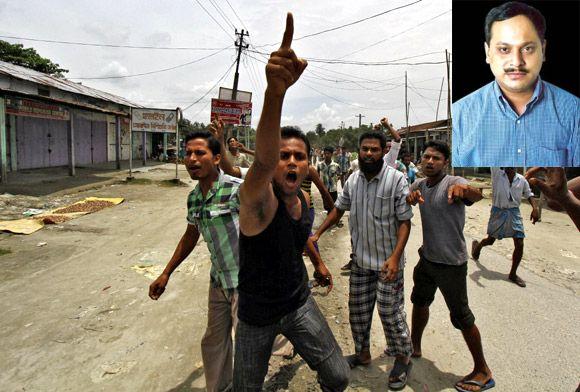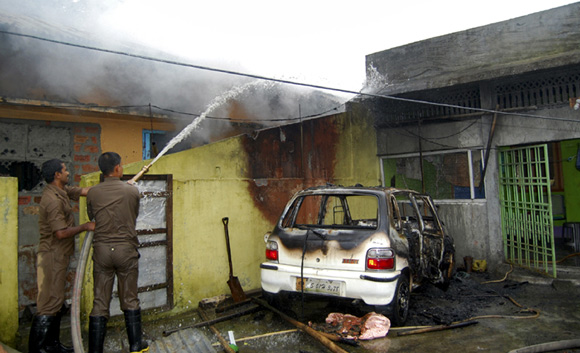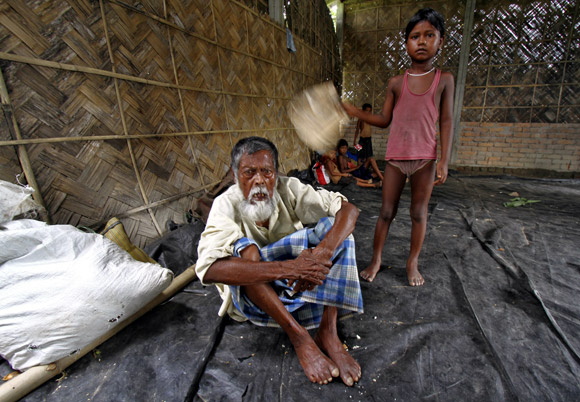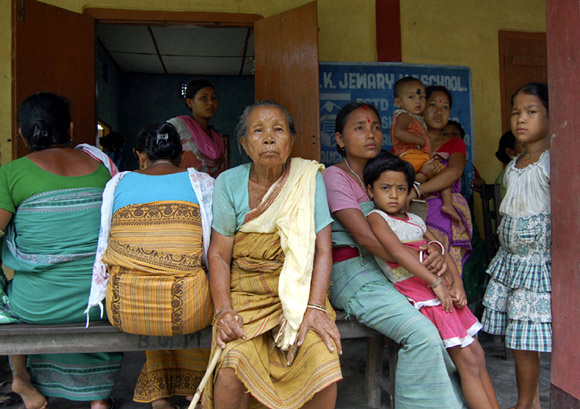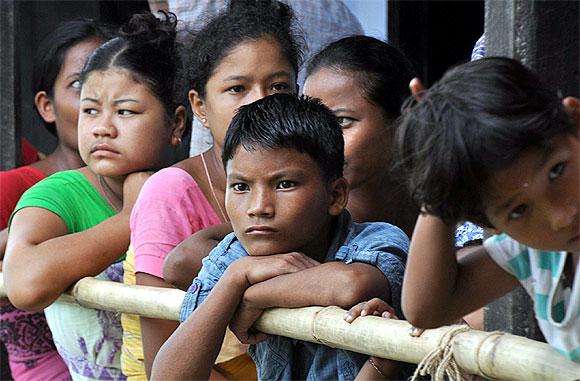 | « Back to article | Print this article |
'Communal explanation to Assam violence is flawed'
Jaideep Saikia, noted terrorism and conflict analyst who has authored the book, Terror Sans Frontiers tells rediff.com's Vicky Nanjappa that the communal explanation -- that is being touted in certain circles amid the recent violence that has erupted in Assam's Bodoland Territorial Autonomous District -- is flawed.
In the interview, he points out that dispensation in both New Delhi and Dispur have turned a blind eye to the problem of illegal migration.
Is the current strife in Assam ethnic or communal?
It is quite clearly a conflict over land, between communities. Indeed, land stands right at the heart of almost all conflict in north-east India.
Perched cheek-by-jowl, tribal communities of differing hues have -- on punctuated occasions -- wrested for rights over land.
Immigrant Bengalis have fought the ethnic tribals in Tripura; Kukis have battled Nagas in Manipur and immigrant Muslims have clashed with the Bodos in Assam, as have the latter with the Santhal community of the state. Even a perfunctory assessment of the inconsistencies in the region cannot substantiate the convenient explanation about such conflicts being sired by religious considerations -- even when the Muslim community is involved.
The communal explanation -- that is being touted in certain circles amid the recent violence that has erupted in Assam's BTAD -- is flawed.
Click on NEXT to read further...
'Pakistani surrogates played a role in fuelling the tension'
The government has claimed that illegal immigration into Assam stopped long ago. If this is the case why has the violence erupted to such an extent today?
Illegal migration is continuing. Dispensations in both New Delhi and Dispur have turned a blind eye to the problem of illegal migration, perhaps because of political expedience.
But, the violence in BTAD is not a result of fresh migration from Bangladesh, but because a stray incident involving different communities triggered off long-standing animosities, primarily over land.
What according to you fuelled the violence and did agencies such as ISI and Bangladesh's Director General of Foreign Intelligence play a role in fuelling the tension?
The lynching of four former Bodo Liberation Tigers cadres in Joypur near Kokrajhar on the night of July 21, 2012 seems to have been the immediate provocation.
Pakistani surrogates -- according to reports -- played a role in fuelling the tension. But this was after the riots broke out. This was reportedly done by sending SMSs and MMSs all over India, thereby triggering an exodus of north-easterners from places such as Bengaluru and Hyderabad. But the hand of interest groups inside India cannot be discounted.
Click on NEXT to read further...
'New-found concern cutting across party lines is heartening'
Does the DGFI continue to encourage the illegal influx and if yes how have they gained?
Lebensraum in the east has been a well grounded agenda for anti-India forces.
However, one aspect that must be comprehended is that almost all migration from Bangladesh is economic. It is the poorest of the poor that migrate to India.
The reason ranges from economic deprivation in the erstwhile East Pakistan to better opportunities in India. It would also be of import to note that global warming and the rising Bay of Bengal will flood 1/4th of Bangladesh. Inhabitants of the lost land will enter India and the influx would have increased manifold.
What roles have the governments of both BJP and Congress played in tackling illegal migration?
Unfortunately neither the BJP (when in office) nor Congress did much to rein in the situation.
As aforesaid, political expedience seems to be the driver for all political formations.
In all fairness it must be said that BJP has at least been raising the issue of illegal migration and NRC update etc, especially after the violence in BTAD. But, even Assam Chief Minister Tarun Gogoi made a statement on August 30 that the NRC updation --perhaps the only way to resolve the illegal migration issue -- would be completed within the next three years. Now, this new-found concern cutting across party lines is heartening. One only hopes that a correct follow-through would take place.
The focus has primarily been on Kashmir. But you have written in detail about the threat the nation faces through these forces in Assam. Has the government and our agencies woken up to this threat or does Assam continue to be a ticking bomb?
The bomb is ticking. The government has to take active remedial measures, and without delay. The recent realisation by North Block mandarins that Pakistani surrogates were involved in the recent crisis is a starter.
Click on NEXT to read further...
'Demise of ethnic militancy in the region has activated Islamists'
Tell us more about the nexus between Islamic militancy and the demographic challenges in the north-east?
I make a distinction between ISLAMIC and ISLAMIST -- the latter being a classification that is erroneously seeking to utilise Islam as a means to further terror: I am quite clear that Islam does not promote terror. Indeed, I have caveated this aspect right in the beginning of my book Terror Sans Frontiers: Islamist Militancy in North East India that I penned almost a decade ago.
The fact that the age-old search for lebensraum in the east would witness an Islamist spill-over from Bangladesh was clear to me way back in 2002. 9/11 had happened and it was a matter of time before the Islamists sought newer pastures -- especially after Op Enduring Freedom and the partial de-Talibanisation of Afghanistan.
Bangladesh and the lower Assam districts provide both a gateway to the rest of India for operations and an after-action pull back area. But it must be said that unlike other states in India the Islamists were not engaging the establishment in the north-east. They did not want to attract attention.
As I wrote in my book, the Islamists are silent, not by the absence of activity but by the presence of non-activity. But, it seems that the demise of ethnic militancy in the region has activated them, albeit in a manner that we are presently witnessing.
Moreover, the loyalties of the illegal migrants from Bangladesh continue to be informed from across the border. The Assamisation process that certain scholars talk about is not taking place despite the fact that such migrants are taking on Assamese sounding names such as Raju and Mamoni.
Also, almost all social formations in the region have their own militias. The vanguards for the Islamists are being provided by the illegal migrants. The increased presence of illegal migrants from Bangladesh is witnessing the growth of Islamist militant groups in the region and even the MHA has recently drawn up a list of such groups.
Click on NEXT to read further...
'The agenda is to bleed India with a thousand cuts'
As you have mentioned the MHA has recently come out with a list of Muslim Fundamentalist Organisations active in Assam and Manipur. There seems to be distinct similarities between the list you had appended in your book Terror Sans Frontiers almost a decade ago and the MHA list of today. Comments.
I do not have the faintest idea from where MHA culled the list from. I am certain that the ministry has better sources than I.
You say that the issue is about terrorism and not religion. Could you elaborate on this point? Also is there a danger that religion could become the focus in the days to come?
Terrorism is, first and foremost, a tactic that involves the threat and use of violence in order to achieve a political goal. The goal may be formulated in ideological or religious terms, but it invariably retains a political component.
Simply put, if there is no political motivation behind a terrorist attack, it can be said that terrorism is not involved. I have spelt this out in my eighth book, Terrorism: Patterns of Internationalization.
I am of the opinion that religion is being used by a new interest group to harness puritans among the faithful for diabolic action. The people who task the puritans are no religious zealots, but ones with a clear political agenda. The agenda is to bleed India with a thousand cuts. I hope and pray that this agenda in the land of Srimanta Sankardeva and Azan Pir can be frustrated.
Click on NEXT to read further...
'Correct diplomatic pressure by New Delhi on Dhaka is needed'
Which are the strongest militant groups in the north-east today?
The NSCN (IM), UNLF and PLA (Manipur) continue to be the strongest militant organisations.
A regime change in Bangladesh is expected and Khaleda Zia is likely to return to power. How would that change the equations in the North East?
The BNP is generally considered to be the anti-thesis of Awami League, which is considered to be somewhat pro-India. The bright side is that Sheikh Hasina has already delivered to India on the issue of ULFA and NDFB to a considerable extent, and it is only a matter of speculation about how the fortunes of the north-east would change were Khaleda Zia to return to power.
Islamism -- the barrack politics of Bangladesh that sired BNP needs the cloak of Islam to retain power -- would certainly receive a fillip and the crackdown on the remaining north-east militants -- billeted in Bangladesh -- would witness demise.
How do you think this issue could be resolved?
Correct diplomatic pressure by New Delhi on Dhaka, even if it borders on coercion. Especially, as it is perfectly capable of it.
Click on NEXT to go further...
Top PHOTO features of the week
Click on MORE to see another set of PHOTO features...
